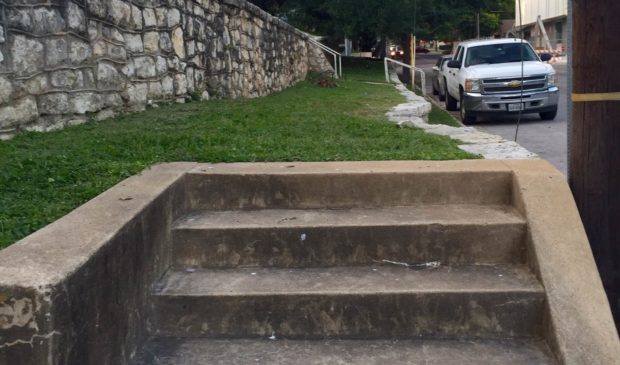With funding still in question, Council approves sidewalk plan update
Tuesday, June 21, 2016 by
Caleb Pritchard City Council last week gave nearly unanimous approval to an update of the 2009 Sidewalk Master Plan.
The 9-0-1 vote comes in the middle of the ongoing debate over a small batch of mobility bond proposals that could go before voters this November.
“Forty years ago, people were not demanding sidewalks,” Council Member Pio Renteria said before the vote. “I used to walk the precincts up north and west and people did not want sidewalks. They didn’t want people walking past their yards. It’s amazing how we now want sidewalks.”
The updated plan includes a recommendation that the city spend $400 million over 10 years to build new sidewalks and improve existing ones. Public Works Department staff estimate that this amount will account for 390 miles of new high-priority sidewalks and bring more than half of the existing network up to what the department deems “functionally acceptable” condition.
As of last November, according to the updated plan, there are 2,580 miles of missing sidewalks in Austin. Of the 2,400 miles of existing sidewalks, fully 85 percent are “functionally deficient,” with severe cracks or other obstructions that render them noncompliant with the federal Americans with Disabilities Act.
Among the competing bond proposals, Council Member Ann Kitchen’s $300 million version specifically earmarks $39.7 million for sidewalks, while Mayor Steve Adler’s $720 million plan would set aside $55 million. Council Member Greg Casar’s plan, the same total cost as the mayor’s, does not specify how much would go to sidewalks, but the $300 million it would spend on local mobility projects and other pedestrian-friendly improvements far exceeds that of the other plans.
While bond money would provide a large boost to sidewalk projects, Public Works staff members are investigating other funding avenues that are outlined in the Master Plan update. Options include development impact fees that could be collected from developers to pay for infrastructure near any given project and not just along its physical borders. Another potential revenue source is an assessment on commercial driveways.
“One of the reasons that that recommendation made it into the plan is it has an added benefit of incentivizing drivewalk reductions,” said the Public Works Department’s John Eastman, coining a term for a wide driveway that spills over a sidewalk. By way of illustration, Eastman showed the Council members a photograph of one business on N. Lamar Boulevard that reduced its 150-foot-wide driveway to two separate 25-foot-wide driveways, thereby reducing the amount of space where drivers and pedestrians could come into contact.
On Monday, Eastman told the Austin Monitor that staff will dig deeper into the details of potential funding and bring back to Council a broad array of options to consider during next year’s budget cycle.
In the meantime, Council made several adjustments to Thursday night’s ordinance that adopted the Master Plan update. An amendment by Council Member Delia Garza raised the scoring matrix for absent sidewalk prioritization for public and private schools. That now puts them on the highest tier, alongside local and state government offices and commuter rail stations.
Two other amendments offered by Kitchen also sailed through. One added language to the scoring matrix that awards points to “places that older adults frequent, which includes health care facilities, clinics, nursing homes, senior living centers and congregate meal sites.”
Her second amendment was aimed at protecting property owners who would otherwise be responsible for removing plants or other obstacles along sidewalks that abut their homes. Kitchen explained that she wanted staff to develop “an appeasement approach for residents who do not have physical or mental capabilities or whom are unable to afford maintaining vegetation around sidewalks at their residences.”
Council Member Leslie Pool expressed reservations about providing such an allowance without also spelling out how to still mitigate the sidewalk obstructions. “I think it would accrue to the city at some level to take on the responsibility,” Pool said. “Somebody’s got to do it.”
After massaging the language of Kitchen’s amendment to instruct staff to report back with a proposal on that measure, Council voted on the ordinance to approve the Master Plan update.
Citing its lack of an explicit financial impact analysis, Council Member Don Zimmerman abstained. Council Member Sheri Gallo was off the dais.
You're a community leader
And we’re honored you look to us for serious, in-depth news. You know a strong community needs local and dedicated watchdog reporting. We’re here for you and that won’t change. Now will you take the powerful next step and support our nonprofit news organization?








